Home »
Misc »
How to pick up a basketball with one hand
How to pick up a basketball with one hand
How To Become Better At Palming A Basketball
Michael Jordan is famous for his big hands (even by NBA standards) and he often used his palming ability to his advantage on the court.
It’s also an essential skill in order to be able to consistently dunk a full-sized basketball.
When I set my goal to be able to dunk a basketball back in 2016, there were two major obstacles.
The main obstacle was being able to jump high enough to get the ball above the rim, and the second was ensuring I could keep a ball under control in order to successfully dunk it without sending it flying off course.
I spent 8-weeks working on my vertical leap. After that, the only thing holding me back from being a good dunker was my ability to consistently palm a basketball.
Big jumps aside, solid palming is essential during the slam dunk
Luckily, I found that training to palm a basketball wasn’t as hard as I expected, despite my smallish sized hands.
I’m first going to discuss two important factors that influence your palming ability, hand size and palming technique, and then cover some methods which will improve your ability to palm a basketball.![]()
Requirement 1: Hand Size
It should be obvious that hand size plays a big role in your ability to palm the ball.
You can have fantastic power and technique but the closer together your fingertips are, a smaller amount of the total pressure will apply an inwards force on the basketball.
Imagine your hand is one inch long – it doesn’t matter how much grip or power you exert, the ball won’t stick. It’s simple physics.
So, is there a ‘bare minimum’ hand size?
Well, technically there isn’t a single measurement that determines whether or not you are capable of palming a basketball.
It’s not just about hand length (measured from the wrist to the top of the middle finger), but also hand span (the distance between your thumb and pinky when you spread your hand out). You could have a relatively short hand length, but have really wide hands, for example.
In addition, finger/grip strength is also part of the equation. You can make up for having smaller hands with greater grip strength.
Your hand size will determine how easy or hard it is to palm a basketball
However, realistically speaking, to be able to comfortably palm a basketball after training technique and strength, here are some ballpark minimum figures.
Hand Length: 7.5″ (this is slightly over the average male hand length of 7.4″)
Hand Span: 8″
With these measurements palming a ball might be a little tricky at first, but if you train your technique and grip strength you’ll ultimately be able to palm the ball fairly comfortably.
People with smaller hands might be able to palm the Basketball, but technique would need to be even better.
For reference, in the NBA draft combine, the smallest hand length you’ll see is typically around 7.75″-8″, although there have been years featuring players with a 7.5″ hand length.
How To Measure Your Hand Length and Span
You will need a standard ruler to find out your own hand measurements.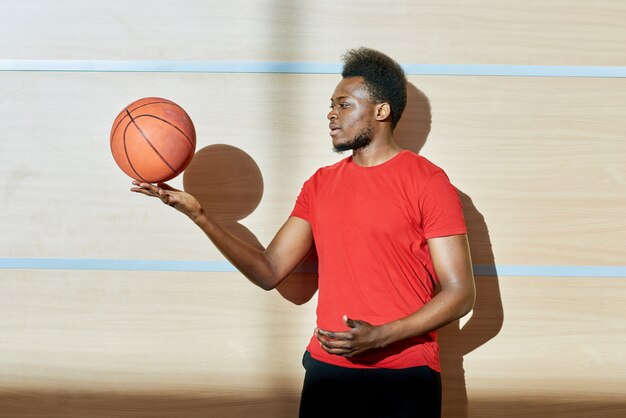
To measure hand length, measure from the base of your hand (where the wrist begins) to the top of your middle finger.
Fig. 1: Measuring Hand Length
To measure hand span, spread your thump and pinky as far apart as you can across a ruler, as shown below:
Fig 2. Measuring hand span
Requirement 2: Strength and Technique
There is definitely more to palming a basketball than pure hand size. In fact, your palming skill is extremely important and will be an equally important factor as your hand size.
Most players didn’t just pick up ta basketball from day 1 and have the ability to palm it securely – unless they’re Michael Jordan.
Basketball players will often subconsciously be practicing palming the ball when they have the ball in their hands.
Once you are able to palm the ball fairly well, it’s just a matter of spending more and more time palming the ball to maintain your ability and further strengthen the muscles involved in palming.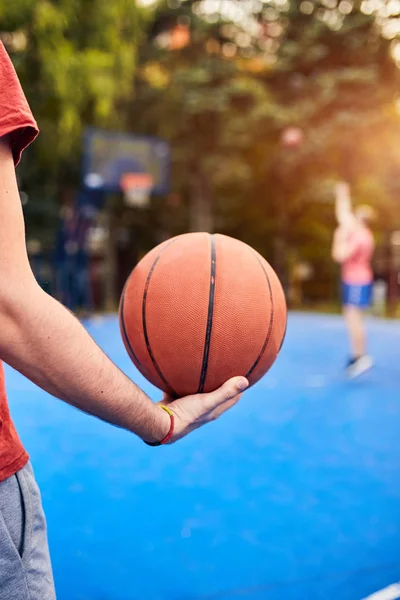
To get to that point, you need to work on your grip strength.
When it comes to grip strength, you need to keep in mind that there are three different types:
- Crush Grip: Grip between fingers and palm that gives you the ability to ‘scrunch’ something – think shaking hands, crushing a beer can.
- Pinch Grip: The grip between fingers and thumb. This is what matters most.
- Support Grip: The grip needed to keep hold onto something – e.g. holding onto a bar during deadlift/pull-ups
For many people, hand grippers spring to mind when they want to improve their hand grip. These things strengthen your hand flexor muscles you use to crush things, but when it comes to palming a basketball, there are more efficient ways of training.
Hand Grippers aren’t very helpful because they don’t reflect the grip used for palming a basketball
The crush grip and support grip are not as important for the purpose of palming a basketball. What needs to be your main focus for training is your pinch grip.
What needs to be your main focus for training is your pinch grip.
Strengthening Your Pinch Grip
Now that we’ve established that you need to strengthen your pinch grip in order to comfortably palm a basketball, let’s go through some exercises you can do to do that.
Fingertip Pushups
These are pretty self-explanatory. Perform a standard pushup but instead of having your palm flat on the ground, lift your palm up so your body is supported by your fingertips.
This is a more challenging variation of the pushup, so if necessary leave your knees on the ground to begin with in order to make the exercise easier.
Fig. 4: Fingertip Pushups
Horizontal Basketball Palming
Since gravity is your enemy, you can start out palming your basketball by palming it horizontally – i.e. parallel to the floor. Since the bottom half of your hand will also be producing an upward force on the ball, it will be easier to palm.
Start palming the ball horizontally to make things easier for yourself
You should feel a burn running down your forearm after doing the exercise for long enough. Don’t overtrain in order to minimize the risk of high muscle tension induced spasm.
Each day, record the maximum number of seconds you can palm the basketball in this manner. You should see continual improvement.
As you improve, gradually start angling the ball towards the floor so that you are less and less reliant on the help you get from the upward forces acting on the ball.
Palming Smaller Balls
When you are trying to strengthen your grip using a basketball, you need to be palming for at least 5 seconds at a time, otherwise your fingers won’t have much opportunity to develop.
If you are unable to do the above exercise for a meaningful amount of time, then instead start off with a smaller leather/rubber ball to practice with.
For this purpose, I’d suggest either getting a womens basketball or a handball (handball is a popular sport in Europe, and the ball is significantly smaller than a Basketball).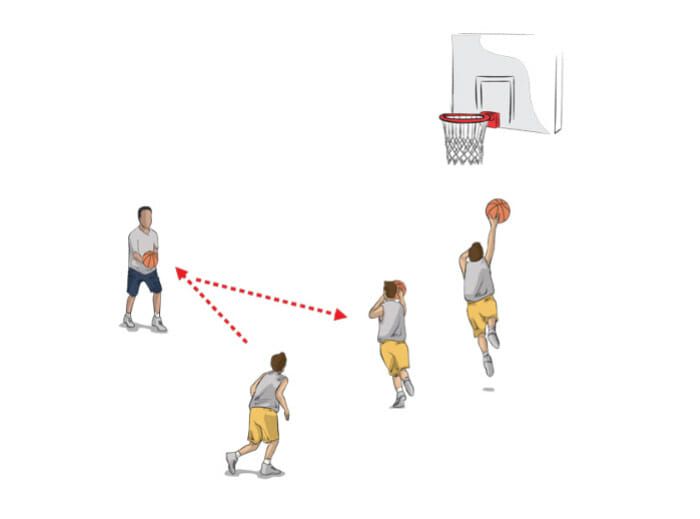
Try and become comfortable palming either of these smaller balls for 20+ seconds before moving on to a men’s basketball.
Finger Stretchers
Unlike hand grippers, finger stretchers are a great way of training finger muscles in isolation. They can be purchased for cheap online and will strengthen the same muscle groups involved in the pinch grip.
Finger Stretchers are a good aid for learning to palm a basketball
Training with a Climbing Wall
If you want to see people with insane grip strength, look no further than climbers.
Because a climbing wall or natural climbing rocks have random contouring, climbers end up stressing different muscle groups during the course of a climb. As a result, you end up training all 3 kinds of hand grip without even realizing it.
I’ve done some climbing sessions before, and noticed immediate improvement to my basketball palming ability shortly after. The burning sensation going down your forearms and fingers after a session is unlike any other.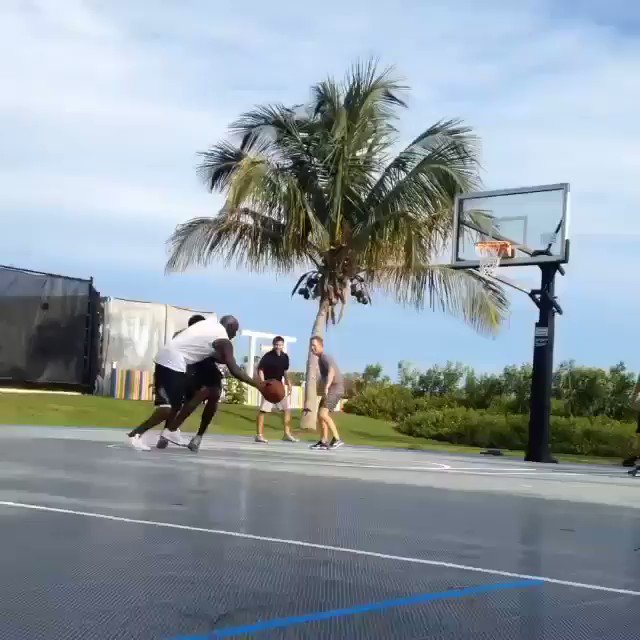
‘True’ Palming vs Pseudo-Palming
You might have read top players like Kobe Bryant or Anthony Davis can’t palm the ball.
Or how about the story that 6’10 Kevin Durant had to tell photographers he wasn’t able to palm the ball when posing for photos?
Yet Kobe, Anthony and Kevin are some of the most efficient dunkers on court. Kevin and Anthony are big guys even by NBA standards.
The point is even these guys have trouble effortlessly palming the ball in the truest sense, and will typically just cradle the ball during a dunk.
When training to palm the ball, your goal therefore isn’t to be able hold a basketball like a tennis ball. Very few people, even in the NBA, actually have that level of control over the ball.
Instead, improve your one-handed control over the ball and get it to a level that allows you to perform the moves you want. In my case, having enough control to dunk the ball was sufficient.
Men Before vs Men Now
Ever notice how your dad’s and his friend’s hands typically look bigger and manlier than yours? It’s not just an age thing – the younger generation are in fact getting weaker.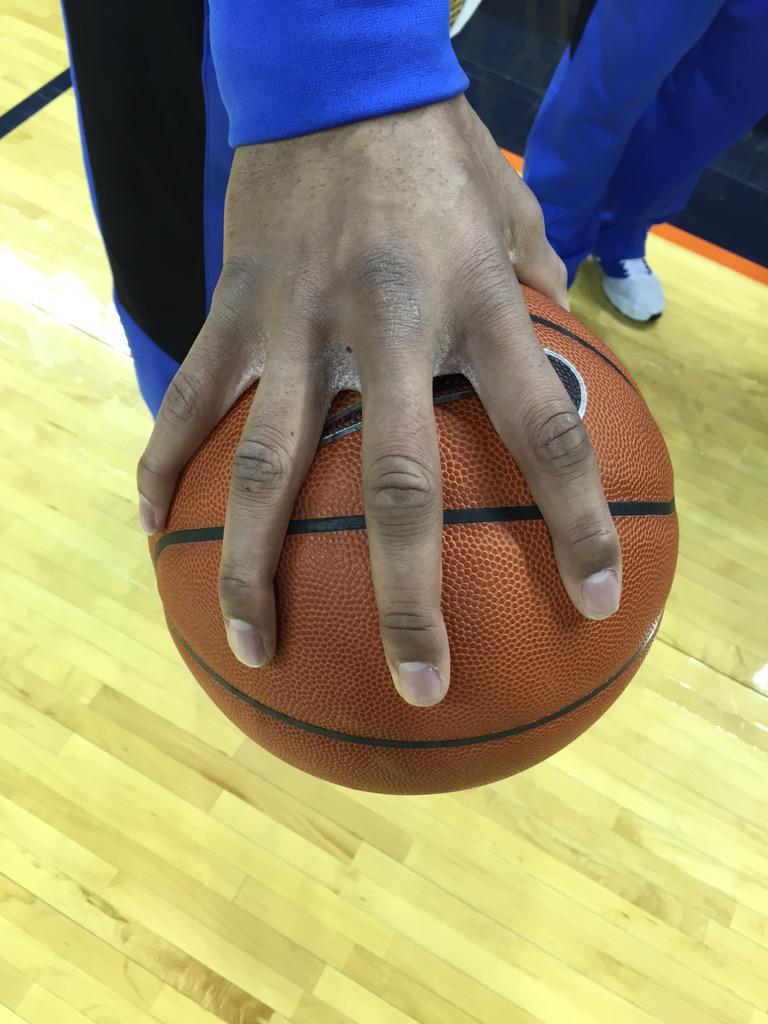
According to a study by the Journal of Hand Therapy, today’s men have a significantly weaker crush and pinch grip than men 30 years ago.
Lifestyle changes have meant that men’s grip strength has decreased over the years
That’s because men’s lifestyles have changed, with a more relaxed, less active lifestyle.
Be it helping with the shopping, going to the gym and doing deadlifts/kettlebell swinging or just playing basketball on a regular basis, you need to get off the computer and get physical.
Grip strength is a strong indicator of strength in general, and if you are finding it difficult to keep a grip on a basketball, your time might be better spent becoming stronger overall than focusing purely on palming in a band-aid manner.
Does The Basketball Make Much Of A Difference?
Yes! Some basketballs are naturally grippier than others. For example, the Wilson Evolution indoor basketball that is popular in college basketball is known to be very grippy. By contrast, the genuine leather official NBA game ball is slightly smoother and harder to palm.
Hopefully this article will help you become better equipped to start working on your ability to reliably hold a basketball. Let me know in the comment section below if you have any other questions!
Basketball Dribbling
Home>Sports>Basketball>Basketball Rules
PreviousNext
Dribbling in basketball is an action the ball-handler can take to move the ball on the court while retaining possession. Dribbling differs from passing since the same player retains control of the ball. Dribbling is a continuous motion that a player uses to repeatedly bounce the ball off the floor with one hand.
Table of Contents
- Basketball Dribbler
- Dribbler’s Options
- Importance of the Dribbler
- Basketball Dribbling Rules
- Picking Up Your Dribble
- Basketball Pivoting
- Dribbling Violations
- FAQ
Basketball Dribbler
The dribbler in basketball is the player who has the ball. Their team is on offense, and they have the option to dribble, pass, shoot, or pivot anywhere on the court.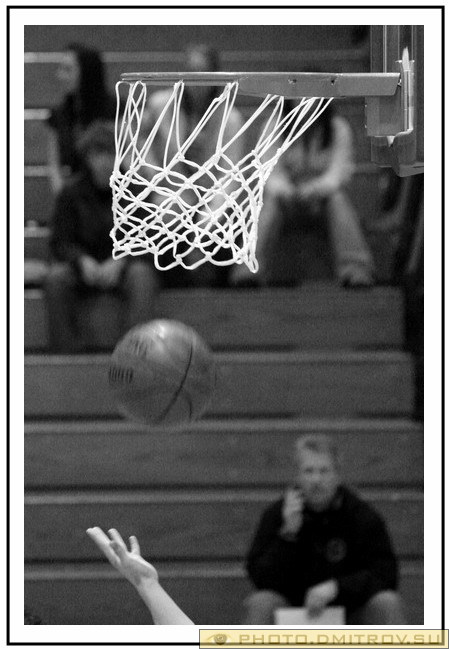
Dribbler’s Options
Once a player receives the ball, they can become a dribbler. The player has a few main options for what they can do with the ball. The player can choose to dribble, moving toward another player, away from the defense, or toward the basket and advance the play further. They can choose to shoot the ball, hoping to make a 2-pointer or a 3-pointer or to possibly earn two foul shots. The player can also choose to pass the ball, whether as a bounce pass, air pass, or a chest pass. Lastly, the player can choose to pivot with the ball to get a new angle or shake off their defender.
Importance of the Dribbler
Since the dribbler is the player with the ball, they are the most important player at that moment. The dribbler has the power to make a play happen and has to make the decision on what to do. The dribbler should become a triple threat to the defender, meaning they can pass, dribble, or shoot at any moment to make that defender’s job more difficult.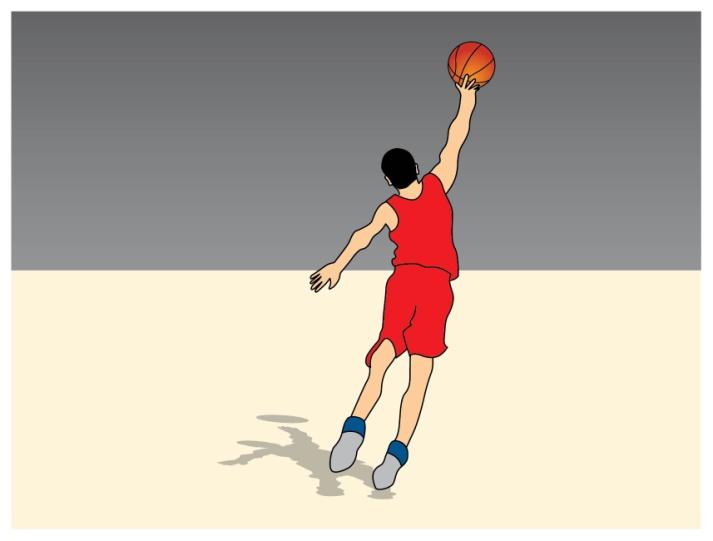
Basketball Dribbling Rules
There are rules in basketball that describe how a player can dribble the ball. Here are the rules of dribbling in basketball:
- You can dribble anywhere on the court as long as you stay inbounds
- You must only use one hand at a time (if two hands touch the ball at the same time, a player loses their dribble and may pass or shoot the ball)
- You may take two steps once you pick up your dribble
- You can bounce the ball off the floor as high as you want as long as your hand stays on top of the ball
- You can not hold the ball in the air while moving on the court
- You can not palm the ball by lifting it into the air with your hand
- You can not stop dribbling and then start again
- Once you dribble across half-court, you cannot cross back to your own half of the court while dribbling or in possession of the ball
Picking Up Your Dribble
At any point, the ball-handler can stop dribbling and pick up the ball. When a player decides to pick up their dribble, they grab the ball and hold it without moving any further after taking their two allowed steps. Once a player picks up their dribble, they can no longer dribble again. Instead, they can only pass, shoot, or pivot.
When a player decides to pick up their dribble, they grab the ball and hold it without moving any further after taking their two allowed steps. Once a player picks up their dribble, they can no longer dribble again. Instead, they can only pass, shoot, or pivot.
Basketball Pivoting
Pivoting in basketball is an action the ball-handler can take by rotating around their pivot foot. The pivot foot is determined as the first foot that touches the ground after a player picks up their dribble If both feet land on the ground at the same time, the player can choose their pivot foot. A player's pivot foot must remain on the ground and stationary when pivoting and can only come off the floor when the player gives up possession of the ball by passing it or taking a shot.
Dribbling Violations
If a player breaks any of these dribbling rules, a violation will be called by the referee. Violations result in a turnover and the other team getting the ball. These are simple mistakes in basketball that can have a large impact during a game.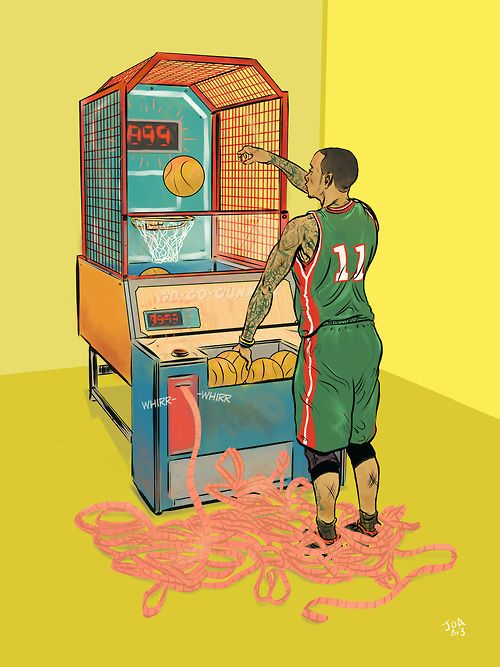 Here is a list of dribbling violations in basketball:
Here is a list of dribbling violations in basketball:
- Traveling
- Carrying/Palming
- Double Dribble
Traveling
When you pick up your dribble in motion, you can only take two steps before a referee calls you for traveling. This often occurs when a player is driving the basket and stops dribbling the ball to go up for a shot or pass. If you pick up your dribble and stop moving, you are no longer allowed to take two steps. Your only option once you stop moving is to pivot, shoot, or pass the ball. Steps can only occur in the process of a motion such as moving or driving to the basket. If a player stops dribbling and takes three or more steps before passing or shooting, they have traveled.
Carrying/Palming
Carrying is when a player places their hand under the basketball and continues dribbling. If you pick up the ball, you must stop dribbling and establish a pivot foot. Carries are often called when players lift the basketball when they dribble. Palming is a form of carrying violation that involves the player holding or gripping the ball in the palm of their hand to help dribble rather than letting the ball hit the ground due to gravity.
Palming is a form of carrying violation that involves the player holding or gripping the ball in the palm of their hand to help dribble rather than letting the ball hit the ground due to gravity.
Double Dribble
Double dribbling is when a player picks up their dribble (stops dribbling) and then starts to dribble again. They cannot do this unless they pass the ball and have it passed back to them. Players have to be careful to continue to dribble if they want to move with the ball and keep possession. Taking multiple steps in between dribbles can also result in a double dribble.
FAQ
What is dribbling in basketball?
In basketball, dribbling is a form of maintaining possession while allowing the player with the ball to move around. Once a player has the ball, they must dribble or pass the ball if they want to move around the court. Dribbling involves the player pushing the ball off of the ground in a continuous motion, allowing gravity to assist. If the player picks the ball up or lets the ball stop moving, the dribble has ended. Once a player picks up their dribble, they can either shoot, pass, or pivot around.
If the player picks the ball up or lets the ball stop moving, the dribble has ended. Once a player picks up their dribble, they can either shoot, pass, or pivot around.
Are you required to dribble the ball in basketball?
You are not always required to dribble the ball. The only time you are required to dribble is if you want to move around while in possession of the ball. If you have possession of the ball, taking any initial steps without dribbling will result in a travel. However, if you do not have the ball, you can move around the court freely. You also can shoot or pass the ball without dribbling, as long as you do not take any steps. Additionally, you can pivot before dribbling when in possession of the ball.
What is a traveling violation in basketball?
A traveling violation is when a player takes more than two steps after picking up their dribble. This usually happens when a player picks up their dribble to shoot or pass. If a player takes more than two steps without passing or shooting beforehand, it will result in a traveling violation and a turnover.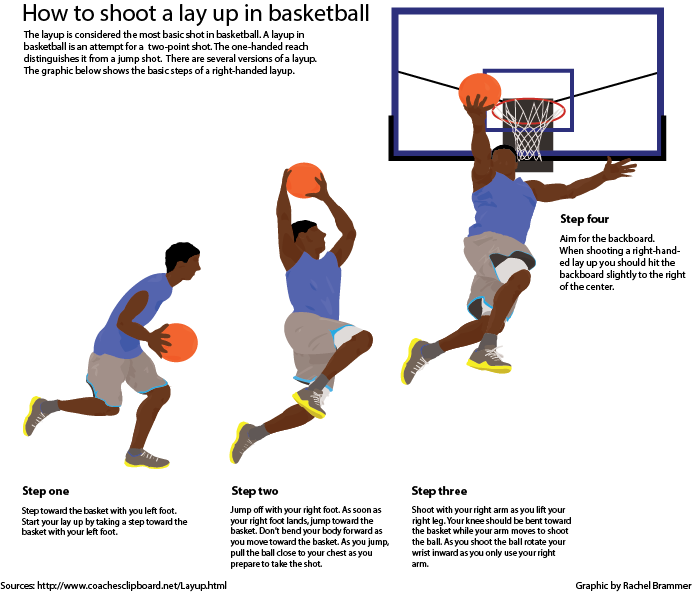 Travels can also happen before a player begins dribbling if they take any steps before beginning their dribble. In this case, a player is allowed to pivot on one foot, but cannot yet take a full step. If a player picks up their dribble and stops moving without taking two steps, they cannot proceed to take two steps later. The two allowed steps must occur within the motion of picking up the dribble.
Travels can also happen before a player begins dribbling if they take any steps before beginning their dribble. In this case, a player is allowed to pivot on one foot, but cannot yet take a full step. If a player picks up their dribble and stops moving without taking two steps, they cannot proceed to take two steps later. The two allowed steps must occur within the motion of picking up the dribble.
PreviousNext
Pages Related to Basketball Dribbling
- Basketball Court Components
- Basketball Court Lines
- Basketball Game Clock
- Basketball Game Length
- Basketball Court Dimensions
- Basketball Free Throws
PreviousNext
How to learn how to spin a basketball on your finger
To skillfully spin a basketball on your finger, you need to learn a few simple techniques, find the ball and set aside 10 minutes of training per day. After a week of practicing your skills, you will master the technique of this trick and show it to your friends. In the step-by-step instructions below, we will show you how to learn how to spin a basketball on your finger.
In the step-by-step instructions below, we will show you how to learn how to spin a basketball on your finger.
Tossing the ball correctly
You can train on the sports ground, near the house or even in the apartment, but in any place you need to take into account the environment. For example, when practicing a trick in a room, the ball can bounce and break fragile objects. When a place is found and inventory is prepared, you can begin training. Initially, you need to learn how to properly hold and throw the ball in the air:
- Hold the ball with the stripes vertical. Horizontal scrolling looks ineffective and it is very difficult to catch a projectile from this position.
- Select throw method:
- Two hands. You need to keep the ball not on the sides, but so that 1 hand “looks” at you, and the second from you. Having fixed the object, sharply spread your arms and slightly “throw” the ball up.
- With one hand.
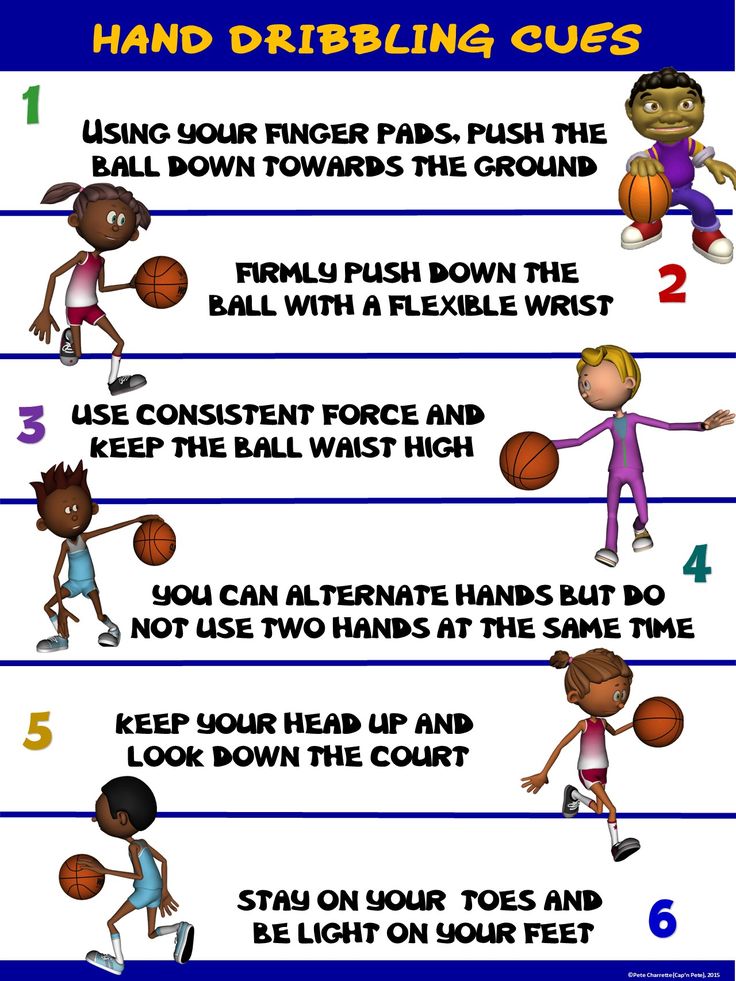 To throw with one hand, place your fingers along the lines of the ball. It is important that there is free space between the palm and the inventory. Lightly squeeze the ball. Turn the brush outward until it stops, and then gently turn it back. At the last moment, you need to give additional rotation to the ball with your fingertips. But we do not recommend using a large one, because. this will upset the balance and the ball will fly away.
To throw with one hand, place your fingers along the lines of the ball. It is important that there is free space between the palm and the inventory. Lightly squeeze the ball. Turn the brush outward until it stops, and then gently turn it back. At the last moment, you need to give additional rotation to the ball with your fingertips. But we do not recommend using a large one, because. this will upset the balance and the ball will fly away.
- Throw the ball parallel to the floor, do not allow the ball to wobble. It is important that when thrown, the projectile rises above eye level. When its bottom surface is visible, the ball is easier to catch.
These steps must be repeated until fully automated. Usually it takes two days. When the throws are confident, you can move on to the second level.
Learning to catch the ball
Once you have learned how to throw correctly, try catching the ball with your finger. To do this, remember the following nuances:
- You need to catch the projectile on the nail, not the finger itself.
 In this case, it is important that the brush is turned with the palm towards you.
In this case, it is important that the brush is turned with the palm towards you. - The finger must be placed strictly in the center, at the junction of the vertical lines, otherwise the ball will slide off.
- When your finger touches the ball, gently and smoothly lower your hand down. So you will improve the cushioning, the inventory will not bounce, and you will not damage your finger.
This stage is one of the most difficult and requires patience on the part of the freestyler, athlete and just wanting to master the skill. When you learn how to catch the ball, at first it can control you: jump off and make you “run” after it to keep your balance. Be patient and keep practicing.
Once you are comfortable with a spinning ball, try to keep it spinning and spin it further. To do this, with light flapping movements, move your free hand along a tangent. But remember that strong twists can shift the center of gravity and the projectile will lose balance.
Tips
Here are some helpful tips from the pros:
- practice throwing a few times a day before moving on to other stages;
- workouts can be quite tiring, so take breaks between sets to give your hands a rest;
- use only a well-inflated ball;
- when accelerating the rotational movements, do not apply much force, otherwise the ball will slip off the finger;
- Trim your nails before practicing, this will increase rotation control;
- do not throw the ball very high: you can damage or break the phalanges;
- You can reduce the risk of wrist injury by warming up before practicing the exercise.
Knowing how to spin a basketball on your finger and approaching the matter responsibly, in a week you will be able to show a cool trick to friends or sports colleagues.
Basketball coaching hacks: how to score goals for beginners
Even if you are a novice basketball player, we will not give you a training plan, but we will tell you why the ball flies anywhere but into the ring and into your hands. It's all about technique: even with regular training and perseverance, novice adults and children often make simple mistakes. It's a shame, let's fix it. Below are 11 life hacks on how to hone your technique to increase the likelihood of a goal for your team.
It's all about technique: even with regular training and perseverance, novice adults and children often make simple mistakes. It's a shame, let's fix it. Below are 11 life hacks on how to hone your technique to increase the likelihood of a goal for your team.
Basketball Shot Rules for Beginners
1. Hands up
In pursuit of the attacker, raise your hands, even if you are standing with your back to the pass, and even more so if the ring is in front of you. Your raised hands will increase the chance of intercepting the ball from the opponent by 2 times. Don't overlook this little thing!
2. Make shield rolls
Even Tim Duncan did not neglect them! A square is drawn on the basketball backboard. If you are standing opposite the ring, then aim at the middle of the upper part of the square, if you are standing on the side, then at the corner. If you hit this square, then the ball is at 90% of cases will fall into the ring. The law of physics and no cheating!
3.
:no_upscale()/cdn.vox-cdn.com/uploads/chorus_asset/file/1396862/hands.0.png)
Look at the ring, not at the ball
Practice driving the ball with your hand, not your eyes, develop tactile control. Your eyes should be on the hoop while dribbling and be aware of the position of your body in relation to the hoop. Then you will be able to take the correct posture, and the throw will be effective.
4. Dribble with the balls of your fingers only
The palm should not touch the ball, only the pads of the fingers. Dribbling should become familiar to you, like an extension of your hand. Then you can change its trajectory at any time and you will have more chances to score goals. Practice with the ball constantly.
5. Throw with one hand
If you throw the ball with two hands, you reduce the chance of hitting the basket. All the efforts of the throw are in one hand (in the right for right-handers, in the left for left-handers). The other hand only holds the ball, the leading one holds it with the fingers, not the palm.
6.

Do not jump when protecting the ring
Jumping is the main mistake of rookie defenders. To intercept the ball and block the shot, simply stick out your hands. When you are in a jump, the attacker will easily bypass you.
7. Don't look back
When you dribble, don't look back, but dribble and aim for the ring, focus on shooting (or passing to another player on your team).
8. Bring the throw to automatism
Incorporate the most basic basketball techniques into your training plan and bring the shot to automatism. Throw at first from a distance of half a meter from the ring, gradually increasing it. Learn to throw the ball so that it hits the ring without touching the edge.
Throw the ball with all fives and jump
Throw rules:
- Head in the center of the body - if tilted, accuracy is lost.
- Look at the ring: mentally build a trajectory. If you are standing far away, then the ball flies in a curved curve with a maximum height of 2 meters above the ring.
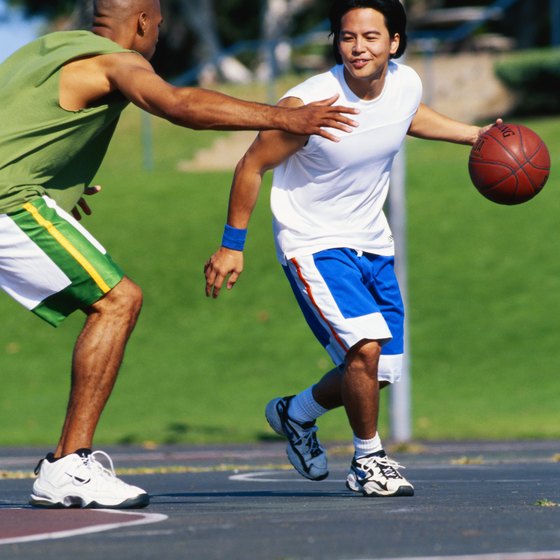
- A strong hand is in front and throws, a weak hand is on the side and directs, only holding the ball. The elbow of the throwing hand must be in line with the ring.
- The ball must rest on the fingers without touching the palm. The fingers are as far apart as possible and grab the ball.
- Throwing arm bent 90 degrees, forearm perpendicular to the floor. If you bend less, then you get not a throw, but a throwing of the ball horizontally.
The main thing in the throw is the position of the body and its balance. Place your feet apart and parallel to each other: it is important to orient them in the middle of the basket. Then the direction of the body during the jump will coincide with the direction of the throw, and the ball will fly straight into the ring. When the feet are uneven, the ball flies in the wrong direction or does not reach (although the throw was normal).
Take a deep breath and release as you exhale.
How to hold the ball and shoot in basketball
How to throw correctly: straighten your arm, point your wrist up, and with your hand set the ball to rotate in the opposite direction from the flight. The ball should seem to "roll" off your fingers.
9. Copy masters and play as a team
Watch professional basketball games and try to copy the movements of your favorite players in training. And be sure to conduct game sparring - this will allow you to develop more techniques.
10. Do not throw in a straight line
The higher the arc of the ball, the greater the chance of a goal and the less chance of blocking by the opponent.
11. Do not throw the ball from a full height stand
This is the biggest newbie mistake!
Before the throw, bend your knees slightly and at the moment of the throw, straighten your body, making a jump. You need to straighten up and push off the ground at the same time. When squatting, keep the elbow of the throwing arm close to the body and towards the ring.